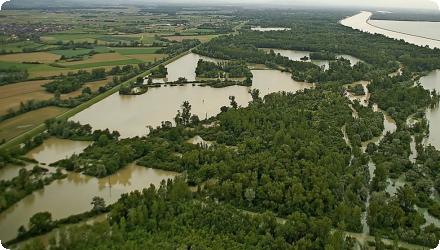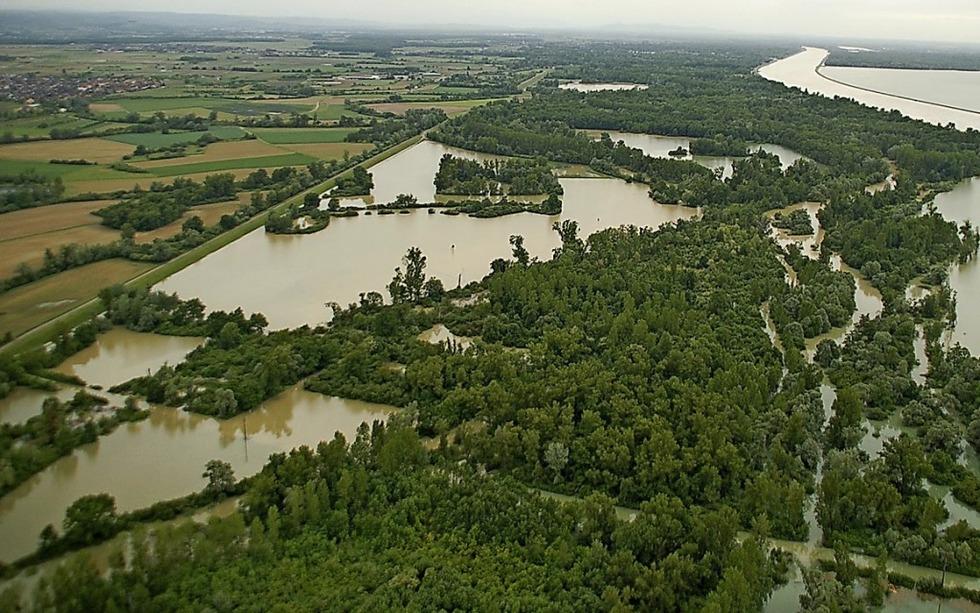Last update
2025
Summary
Ecological flooding has been implemented in a polder area near Altenheim, Germany, as part of the Integrated Rhine Programme (IRP). Covering approximately 520 hectares, the Altenheim polders serve a dual function: ecological enhancement and flood retention, with a capacity of up to 17.6 million m³. Since 2001, controlled ecological flooding is triggered when the Rhine’s flow exceeds 1550 m³/s, with infrastructure allowing flows up to 80 m³/s. This approach has significantly improved biodiversity, groundwater dynamics, and habitat conditions.
The project also created recreational opportunities and enhanced landscape connectivity. However, challenges arose related to forest adaptation (notably shifts in tree species), mosquito proliferation, and groundwater level management. In response, new measures were introduced—including permanent swing barriers (installed in 2021) to protect wildlife during floods, and coordinated post-flood clean-ups involving local authorities and forestry services.
Recent evaluations confirm ongoing positive ecological effects, including increased amphibian, fish, and mammal presence. Regular maintenance and monitoring are coordinated by the Regional Council (Regierungspräsidium Freiburg), ensuring the multifunctional goals of flood protection, ecological restoration, and local engagement are maintained.
The project also created recreational opportunities and enhanced landscape connectivity. However, challenges arose related to forest adaptation (notably shifts in tree species), mosquito proliferation, and groundwater level management. In response, new measures were introduced—including permanent swing barriers (installed in 2021) to protect wildlife during floods, and coordinated post-flood clean-ups involving local authorities and forestry services.
Recent evaluations confirm ongoing positive ecological effects, including increased amphibian, fish, and mammal presence. Regular maintenance and monitoring are coordinated by the Regional Council (Regierungspräsidium Freiburg), ensuring the multifunctional goals of flood protection, ecological restoration, and local engagement are maintained.
Position
Latitude
48.464318
Longitude
7.809403
Project
NWRM
National Id
Germany 02 light
Installation date
1987
Implementation Status
Contact
Sabine Tutte, ACTeon
RBD code
DE2000
Transboundary
0
Photo gallery
Location of the project
The Altenheim polder area is located west of the village of Altenheim (part of the municipality of Neuried), in Baden-Württemberg, Germany.
NUTS Code
DE13 - Freiburg
Involved Partners
| Authority type | Authority name | Role | Comments |
|---|---|---|---|
Climate zone
cool temperate dry
Temperature
9,5
Precipitation
800
Runoff
1060
Runoff range
600 - 750 mm
Slope range
0-1%
Vegetation class
Alluvial floodplain forest.
This includes species typical of temperate riparian zones along the Upper Rhine, such as:
Hardwood species: oak (Quercus robur), ash (Fraxinus excelsior), elm (Ulmus spp.)
Softwood zones (in wetter areas): willow (Salix spp.), poplar (Populus spp.)
Understory and ground vegetation: includes reed beds, sedges (Carex spp.), and other floodplain herbaceous plants
This includes species typical of temperate riparian zones along the Upper Rhine, such as:
Hardwood species: oak (Quercus robur), ash (Fraxinus excelsior), elm (Ulmus spp.)
Softwood zones (in wetter areas): willow (Salix spp.), poplar (Populus spp.)
Understory and ground vegetation: includes reed beds, sedges (Carex spp.), and other floodplain herbaceous plants
Performance timescale
Immediate
Project area
520
Area subject to Land use change or Management/Practice change (ha)
520
Use for retention approx. every 10 years.
Design capacity description
17.6 Mio m³
Total cost
€ 1,300,000,000
Costs investment information
The adaptation of the forest was "cost neutral" since the community of Altenheim used the money received by the state as compensation to place funds and the interests are invested into forestry.
Costs capital
1300000000
Costs capital information
This money had to be invested for the 13 retention areas of the Integrated Rhine Programme.
Costs operation maintenance
450000
Costs operation maintenance information
Upkeeping costs per retention area. This depends on the length of the dykes, the number of pumping stations, the length of streets inside the polder etc.
Administrative annual costs
100000
Financing authorities
Type of funding
National funds
Type of funding
Sub-national funds
Compensations
1
Compensations annual information
Every landowner inside the polder receives 20% of the land value as compensation. In return the Regional Council Freiburg enters to the title register. Forest owners are compensated once, since it is too complex to discuss after every flooding whether damages are new or old. After flooding events experts assume the damage happen on fields and the farmers are compensated individually
Policy context
Physical alteration of the channel, the river bed and the floodplain due to hydropower plants, flood protection and an easier navigability on the Rhine.
Land ownership
The land is mainly publicly owned by the State of Baden-Württemberg, with some areas owned by the municipality of Neuried and private landowners. The site is managed by the Regional Council of Freiburg.
Community involvment
Yes
Design consultation activity
| Activity stage | Name | Key issues | Comments |
|---|---|---|---|
|
Implementation phase
|
Information evenings
|
Since the ecological flooding is a quite new concept publicity has to be done in order that neighboring communities accept it. This has to be done continously. The polder Altenheim is a good exemple that shall calm down the worries of other communities were a polder shall be constructed
|
|
|
Other
|
site visits
|
Policy target
| Target purpose |
|---|
|
Increase Water Storage
|
|
Peak-flow reduction
|
|
Improved Biodiversity
|
Policy pressure
| Pressure directive | Relevant pressure |
|---|
Policy impact
| Impact directive | Relevant impact |
|---|
Requirement directive
| Requirement directive | Specification |
|---|
Contractual arrangements
0
| Arrangement type | Responsibility | Role | Name | Comments |
|---|---|---|---|---|
|
Contractual agreement
|
Responsible
|
Treaty of Versailles
|
Treaty between France and Germany allowing France using the Rhine for Hydropower. Due to the construction of numerous dams the Rhine lost 90% of its floodplain and made the integrated rhine programme necessary
|
|
|
Organisational arrangement
|
Supporting
|
Comission for the Protection of The Rhine
|
The riparian countries of the Rhine formed this comission to improve the water quality and the overall ecological state of the river. Navigability is moreover an important issue
|
Part of wider plan
1
Wider plan type
| Wider plan type | Wider plan focus | Name | Comments |
|---|---|---|---|
|
Integrated Rhine Programme
|
The main focus of this programme is flood protection by restoring the floodplain on the upper Rhine upstream of Karlsruhe.
|
Inside the polder several parameters were monitored to document the impact of ecological flooding on water and matter balance, state of groundwater, water courses and lakes, soil and biodiversity. Moreover, the water retention during flood events was documented.
Catchment outlet
The amount of terrestrial plants and the domination of single species in different vegetation layers was determined by rough assuming. Aquatic macrophytes were documented by the estimation method of Kohler and Janauer. Beetles were counted by pitfalls, the diversity of birds was determined by observing and counting nests.
Lease of land around the swimming lake.
Recreational value since the polder area is used for hiking, jogging, cycling and canoeing.
Hydrological effects
Strong influence on the fluctuation of the water table.
Information on increased water storage
The water is stored in watercourses inside the polder and in case of retention also in the forest.
Information on runoff reduction
No data available.
Information on Peak flow rate reduction
During the last flood on the Upper Rhine in the 90's, the water retention inside the polder led to a reduction of the gauge of 24 cm and avoided thus the inondation of important industrial cities (Karlsruhe, Speyer, Mannheim).
Information on Increased groundwater level
Ecological Flooding leads to rising groundwater levels outisde the polder that can affect property. Therfore a complex drainage system including channels, wells,lakes and pumping stations was created.
Information on Restoring hydraulic connections
In order to distribute evenly water inside the polder, a system of water courses was reconnected and restored, the so called Schluten
Water quality overall improvements
Negative impact-WQ deterioration
Information on Water quality overall improvements
Measurements have shown that the overall water quality of the Rhine deteriorates when the water passes the polder. However, no danger for the drinking water supply exists.
Soil quality overall soil improvements
Positive impact-SQ improvement
Information on Soil quality overall soil improvements
Due to ecological flooding, the forest soil is constantly enriched by organic sediments serving as fertilizer for the plants.
1
Due to ecological flooding alluvial plant and animal communities could be established. The floods diversify the water courses which thus became habitat of different invertebrate and fish species. Several groundbeetle and dragonfly species came back to the new established alluvial forest. However, the regular flood events are source of mosquito pests that require a treatment by the members of a taskforce.
Ecosystem impact climate regulation
No information available
Ecosystem provisioning services
0
Key lessons
It is possible to adapt and modify the ecosystem inside a polder to water retention events by ecological flooding. Due to the measures the polder became a valuable recreational area for the citizens of the neighboring community. However, expensive protection measures for Altenheim are needed to avoid damage by rising groundwater level in consequence of ecological flooding.
Success factor(s)
| Success factor type | Success factor role | Comments | Order |
|---|---|---|---|
|
Attitude of decision makers
|
main factor
|
<p>The regional council had to meet many restrictions (international contracts, lack of space). Nevertheless, they created with the polder Altenheim an example for the whole Integrated Rhine Programme (IRP) showing that ecological flooding works and that a polder area has multiple benefits.</p>
|
1
|
|
Financing possibilities
|
main factor
|
<p>The maintenance of a polder is very expensive. The international importance of the project enabled the mobilisation of sufficient funds.</p>
|
2
|
|
Attitude of relevant stakeholders
|
secondary factor
|
<p>One argument against ecological flooding is the fear of people towards a mosquito pest. Several communities formed a tasked force (the KABS), which is controling the mosquito population. This programme is very complex but effective.</p>
|
3
|
Driver
| Driver type | Driver role | Comments | Order |
|---|---|---|---|
|
Legal obligations
|
main driver
|
A sudden inondation of the polder would have caused a severe impact on the ecosystem. According to law, impacts have to be avoided, minimised or balanced. This led to the development of the ecological flooding concept.
|
1
|
|
Legal obligations
|
secondary driver
|
Determines the amount of ecological flooding depending on the Rhine discharge.
|
2
|
English

